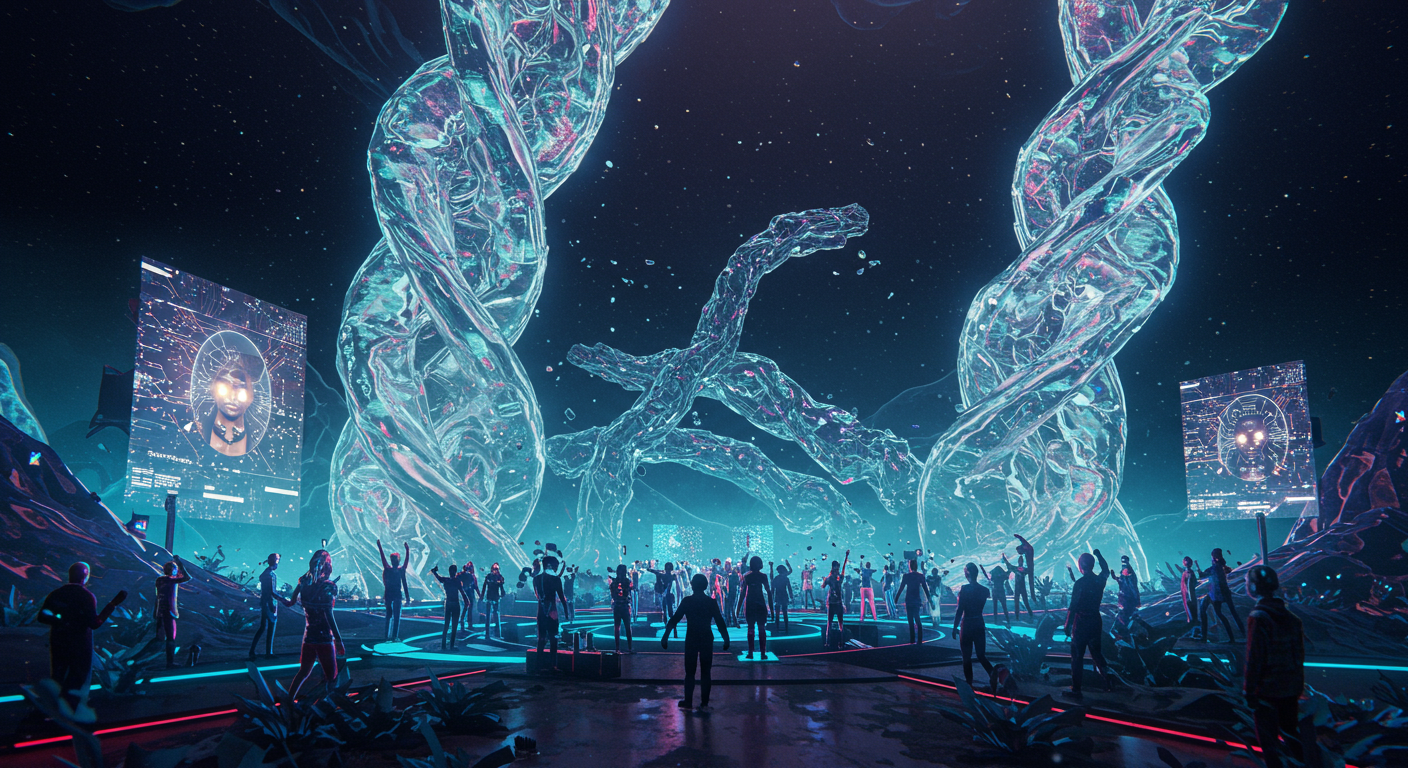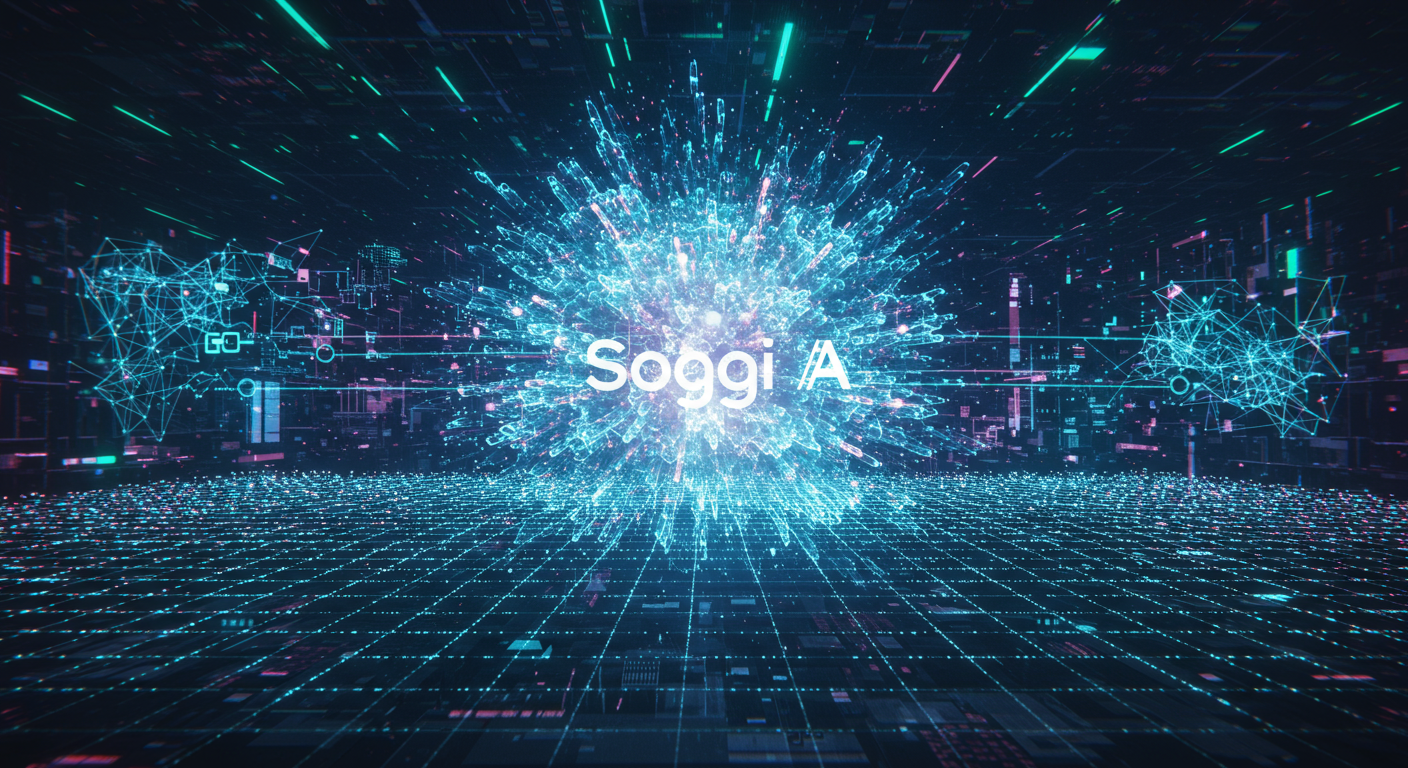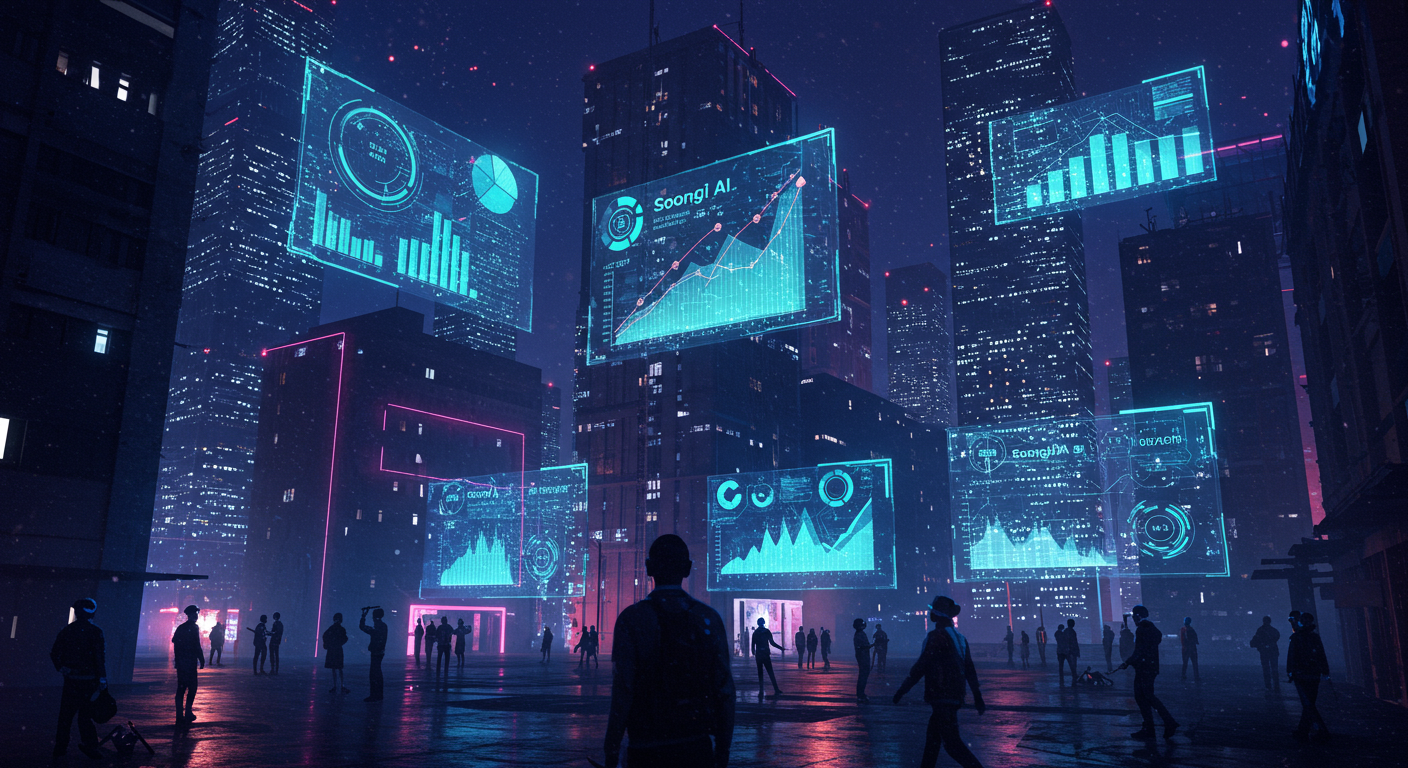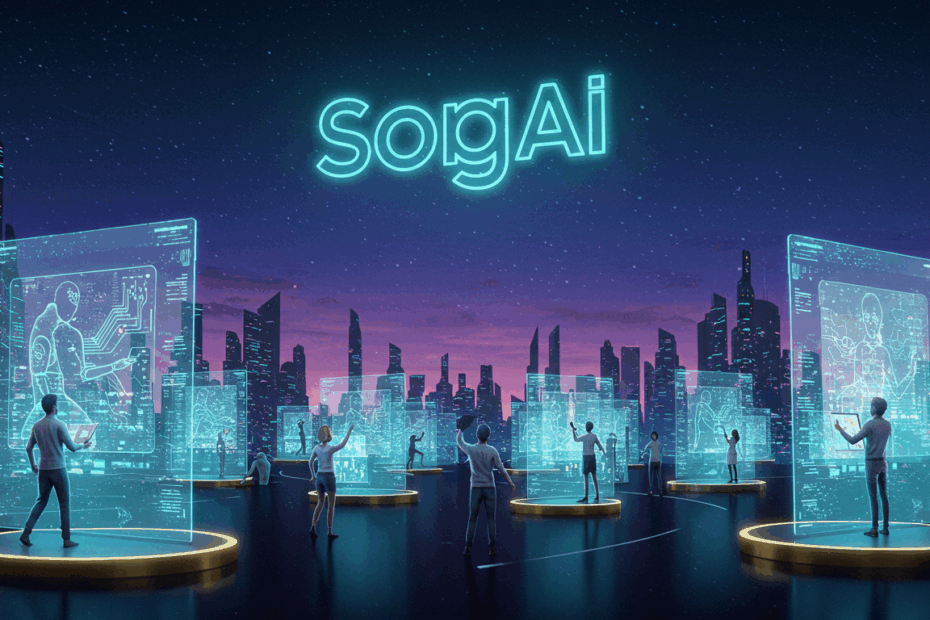Sogni AI’s Mainnet is Live: A Deep Dive into the Future of Decentralized Creative AI
John: It’s a big day in the world where AI and Web3 intersect, Lila. Sogni AI, a project that’s been on my radar for a while, has just successfully launched its mainnet. This isn’t just a minor update; it’s the full-scale deployment of their decentralized creative-AI platform. The buzz is palpable, especially with the simultaneous listing of their native SOGNI utility token on major Tier-1 exchanges like Kraken, MEXC, and Gate.io.
Lila: Okay, John, that’s a lot of industry jargon right out of the gate! Let’s break it down for our readers who might be new to this. When you say “Sogni AI,” what are we actually talking about? Is it another AI image generator like Midjourney?
John: That’s a fair question, and it gets to the heart of what makes Sogni different. While it does offer professional-grade creative tools, including AI art generation, thinking of it as just another Midjourney is like comparing a community-owned supercomputer to a single laptop. Sogni AI is fundamentally a decentralized creative AI platform and GPU render network. It’s an entire ecosystem, not just a single application.
Lila: A community-owned supercomputer? I like that analogy. So, instead of a big tech company owning all the powerful computers needed to run the AI, Sogni’s network is powered by… whom, exactly?
John: Exactly. It’s powered by its users. Anyone with a capable GPU (Graphics Processing Unit – the powerful chips used for gaming and complex calculations) can contribute their idle computing power to the network. In return, they get rewarded. This creates a distributed, global network for AI tasks, which aims to be more open, affordable, and censorship-resistant than the centralized alternatives we see today.

What is Sogni AI? The Basics Explained
Lila: So, if I’m a digital artist, what does Sogni AI offer me? And if I’m just someone with a good gaming PC, what’s in it for me? It sounds like two different worlds.
John: It’s designed to bring those two worlds together. For the artist, Sogni provides a suite of tools called Sogni Studio. This is where you can create AI-generated art, render complex 3D models, create animations, and more. The key difference is that when you hit “render,” your task isn’t sent to a server owned by a single corporation. Instead, it’s broken down and distributed across that decentralized network of GPUs I mentioned.
Lila: So my artwork is being created by a swarm of computers all over the world? That’s pretty cool. And for the person with the gaming PC?
John: For the GPU provider—the person with that gaming PC—it’s an opportunity to monetize their hardware when they’re not using it. Instead of their powerful graphics card sitting idle, they can run the Sogni client, process tasks for artists on the network, and earn the platform’s native tokens as a reward. It democratizes access to high-performance computing on both sides of the equation.
Lila: Democratizes… I see that word a lot. So it means making these powerful AI tools cheaper and more accessible for creators, while also giving hardware owners a way to earn? That makes sense. The “mainnet launch” we’re discussing today is the moment this whole system went from a test phase to being fully live and operational, right?
John: Precisely. Before this, they were on a testnet (a testing environment for the blockchain), where transactions and activities weren’t real. The mainnet launch, which happened on July 2nd, 2025, signifies that the Sogni AI platform is now fully live on the Base Mainnet. The economy is real, the tokens have value, and the network is performing its intended function. It’s the “go-live” moment every crypto project works towards.
The SOGNI Token: Understanding the Supply and Utility
Lila: You mentioned tokens. The search results are full of talk about the “SOGNI utility token.” What is its role in this ecosystem? Is it just for trading on exchanges like Kraken and MEXC?
John: While the exchange listings provide liquidity and price discovery, the SOGNI token’s primary role is its utility within the ecosystem. It’s the economic engine. Sogni actually uses a dual-token system, which is an interesting approach. The two assets are:
- SOGNI ($SOGNI): This is the main utility token. It’s an ERC-20 token (a standard type of token built on a network compatible with Ethereum, in this case, Base) and it’s the core currency of the platform.
- Spark ($SPARK): This is a secondary, non-transferable token used for specific in-platform actions.
Lila: A dual-token system? Why not just have one? What does each one actually do?
John: It’s a design choice meant to balance the economy. Think of SOGNI as the hard currency and Spark as a sort of “energy” or “credit” point.
SOGNI’s main functions are:
- Payments for Compute: Artists and developers use SOGNI to pay for the GPU rendering and AI processing services on the network.
- Staking: GPU providers, or “Compute Providers,” must stake (lock up) a certain amount of SOGNI to be eligible to receive jobs and earn rewards. This acts as a security deposit, ensuring they act honestly.
- Governance: In the future, SOGNI holders will likely be able to vote on proposals that shape the future of the platform, making it a truly decentralized, community-run project.
Lila: Okay, so SOGNI is the real money of the Sogni economy. What about Spark? Where does that fit in?
John: Spark is more of an operational token. You can think of it as the “gas” needed to perform creative tasks. For instance, you might earn Spark for certain activities or get an allocation of it, and then you spend Spark to generate an image or run a small task in Sogni Studio. It’s designed to encourage platform engagement without requiring users to spend the more valuable SOGNI token for every single click. This can lower the barrier to entry for new creators just wanting to experiment.
Lila: So, to summarize: Artists pay with SOGNI for big jobs, GPU providers stake SOGNI to work and get paid in SOGNI, and everyone might use Spark for smaller, everyday creative actions. It’s a self-contained economy.
John: An excellent summary. And the mainnet launch means this entire economic loop is now active.
How it Works: The Technical Mechanism of Sogni AI
Lila: I’m still trying to wrap my head around the “decentralized GPU network.” If I submit a request to create an AI image, how does Sogni ensure it gets done correctly and that I’m not overcharged? It seems chaotic compared to just using a single company’s service.
John: It’s a complex but elegant system. At its core, Sogni AI is built as a Layer 1 (L1) chain, but more specifically, it’s a Supernet on Base. Let’s unpack that. Base is a Layer 2 (L2) scaling solution for Ethereum, known for its low fees and fast transactions. Sogni leverages this by building its own specialized network, a “Supernet,” on top of it. This gives them the security and connectivity of the broader Ethereum ecosystem while allowing for the customization needed to run a high-throughput compute network.
Lila: Okay, so it’s like building a specialized highway system that connects to a major national interstate. It gets the benefits of the main system but is designed for a specific purpose. How does the job get done on this “highway”?
John: When an artist submits a job, the Sogni network acts as a smart marketplace.
- Job Submission: The creator defines their task (e.g., “render this 3D scene,” “generate an image from this prompt”) and the SOGNI they are willing to pay.
- Node Selection: The network identifies available and suitable GPU providers (nodes) who have staked SOGNI. The selection can be based on factors like their hardware capabilities, reputation, and network speed.
- Task Execution: The job is sent to the selected node(s). For very large tasks, it could potentially be split among multiple nodes.
- Verification: This is the crucial part. The network needs a way to verify that the job was completed correctly before releasing the payment. This often involves cryptographic proofs or a reputation system where nodes that deliver good work are prioritized for future tasks, while those that fail are penalized.
- Payment: Once the work is verified, the smart contract (a self-executing contract with the terms of the agreement directly written into code) automatically releases the SOGNI payment from the artist to the GPU provider.
Lila: So the blockchain and smart contracts act as the trust layer, the automated escrow agent that makes sure everyone plays fair. And because it’s built on Base, the cost of all these little transactions should be minimal, making it viable?
John: Precisely. That’s the promise of decentralized compute networks: trustless, efficient, and globally scalable. It removes the need for a central intermediary to broker these transactions, which in theory, should lead to lower costs for creators and higher payouts for compute providers.

Team, Community, and The Power of Decentralization
Lila: Who is actually building all of this? Is there a big, known team behind Sogni AI? In the crypto space, that can be a major factor for trust.
John: The information on the core team is somewhat typical for a crypto project—often a mix of publicly known advisors and pseudonymous core contributors. What’s more important in a decentralized project like this, however, is not just the initial team but the community they foster. The goal is to eventually transition to a DAO (Decentralized Autonomous Organization), where the SOGNI token holders—the actual users and providers—govern the protocol.
Lila: So the community *is* the long-term team, in a way. I’ve seen a lot of talk about their airdrop. Is that part of building the community?
John: Absolutely. An airdrop is a method of distributing a project’s tokens to early users and community members, often for free. The Sogni AI airdrop was designed to reward early testnet participants and bootstrap the network with a wide, distributed base of token holders from day one. It serves two purposes: it rewards early believers and it helps decentralize the token supply, which is critical for a healthy, community-run ecosystem. A project with all its tokens in a few hands isn’t truly decentralized.
Use Cases and Future Outlook: More Than Just Art
Lila: Okay, we’ve established it’s a decentralized creative platform. We’ve talked a lot about AI art, but what else? What is the grand vision for Sogni AI? Where could this go in five years?
John: The initial focus on creative AI is smart, as it’s a field with an immediate and voracious appetite for GPU power. But the underlying infrastructure is much more versatile. The potential use-cases are vast:
- 3D & VFX Rendering: For indie filmmakers and game developers who can’t afford massive render farms.
- Scientific Computing: Researchers could tap into the network for complex simulations in fields like drug discovery or climate modeling.
- AI Model Training: The network could be used not just to *run* AI models, but to *train* new ones, which is an incredibly compute-intensive process.
- Decentralized Physical Infrastructure Networks (DePIN): Sogni is a prime example of a DePIN project. This is a growing narrative in crypto that focuses on using blockchains and tokens to build and manage real-world infrastructure, in this case, a compute network.
Lila: So the “Creative AI” part is just the first application on top of this much bigger “decentralized supercomputer” they’re building. The future potential seems huge if they can achieve that scale.
John: That’s the long-term bull case, yes. Imagine a world where any developer can access massive computational power without needing permission from Amazon, Google, or Microsoft. That’s the paradigm shift Sogni AI and other projects in this space are aiming for. Their slogan, “Freedom to Create, Power to Earn,” really encapsulates this dual-sided vision.

How Does Sogni AI Compare to Competitors?
Lila: This sounds amazing, but they can’t be the only ones with this idea. I’ve heard of other projects like Render Network (RNDR) and Akash (AKT). How does Sogni AI stack up against them? What makes it different?
John: An important question. This is a competitive space. Render Network is arguably the most established player, focusing on decentralized GPU rendering for artists. Akash is more of a generalized cloud computing marketplace. Sogni AI seems to be carving a niche that sits somewhere in between, with a stronger initial focus on the entire *generative AI workflow*.
Here’s a quick comparison:
- Render Network (RNDR): Very focused on rendering for 3D artists, with deep integrations into software like OctaneRender. It’s the market leader in that specific vertical.
- Akash Network (AKT): A broader, more permissionless “supercloud” for developers to deploy Docker containers. It’s more geared towards general backend computing than specifically creative workflows.
- Sogni AI (SOGNI): Sogni is targeting the intersection of these. It’s not just about rendering a final product but also about providing the tools and compute for the *creation process* itself—the generative AI part. The Sogni Studio and the focus on AI-native workflows are key differentiators. Building on Base also gives it an edge in terms of tapping into a modern, fast-growing L2 ecosystem.
Lila: So, it’s more of an all-in-one suite for the AI creator, from generation to final render, whereas competitors might focus on just one piece of that puzzle? And its choice of underlying technology—the Base Supernet—is a modern approach?
John: That’s a good way to put it. It’s an integrated platform play, which can be very appealing to users who don’t want to stitch together five different services to complete a project. Success will depend on how well they execute on that integrated vision.
Risks, Cautions, and What to Watch For
Lila: As exciting as this all is, we have to be responsible journalists. What are the risks? This is crypto and AI—two of the most hyped and volatile sectors out there. What could go wrong?
John: As the veteran in the room, I appreciate you bringing that up. The risks are significant and should not be ignored.
- Adoption Hurdles: Sogni AI needs to attract both sides of its marketplace in large numbers. It needs a critical mass of artists to provide demand and a critical mass of GPU providers to supply the compute. Solving this “chicken and egg” problem is the primary challenge for any two-sided marketplace.
- Technological Complexity: Running a decentralized compute network is incredibly difficult. Ensuring jobs are routed efficiently, work is verified correctly, and the network is secure from attack are non-trivial engineering challenges. Any major bugs or exploits could be catastrophic.
- Competition: As we discussed, they are not alone. They face stiff competition from established Web3 players like Render and from the centralized giants (AWS, Google Cloud) who are not standing still.
- Token Volatility: The SOGNI token, like all crypto assets, will be subject to market volatility. Its price will be influenced by broad market trends, speculation, and project-specific news, which can create an unstable economic environment for platform users if not managed well.
Lila: So, potential users and investors should look for steady growth in both the number of creators using the platform and the number of active GPU nodes. That would be a key health metric, right?
John: Exactly. Track the on-chain metrics. Look at the number of jobs being processed, the total SOGNI being staked, and the growth of the developer community. Those are the real indicators of success, far more than the daily price chart.
Expert Opinions and Market Sentiment
Lila: What’s the general feeling out there? I saw a tweet from crypto influencer Mario Nawfal saying he was “excited to see their transition to mainnet.” What are other analysts and news outlets saying?
John: The sentiment is broadly positive but cautiously optimistic. The news coverage, from outlets like CoinDesk to CryptoPotato, has focused on the key facts: the mainnet launch, the Tier-1 exchange listings, and the project’s mission to build a decentralized platform for generative AI. Analysts are highlighting its position within the DePIN and AI narratives, which are two of the strongest trends in the current crypto cycle.
Lila: So the story is strong. But what’s your personal take, John? After covering this space for years, does Sogni AI have what it takes?
John: My take is that Sogni AI is launching the right product at the right time. The demand for AI compute is exploding, and the limitations and costs of centralized providers are becoming painfully obvious. Their integrated approach with Sogni Studio is a clever strategy to onboard users. However, execution is everything. The next six months will be critical. They need to prove their technology is robust, their tokenomics are sustainable, and their community-building efforts are effective. It’s a high-potential project in a high-risk, high-reward field.
Latest News and Roadmap
Lila: So, to wrap up the current situation, what’s the absolute latest news and what should we be looking for next on their roadmap?
John: The biggest news is, of course, the July 2nd mainnet launch and the SOGNI token going live on Kraken, MEXC, and Gate.io, with trading now active. Looking ahead, we should consult their official roadmap, but we can anticipate key milestones will include:
- Expanding the Sogni Studio Toolset: Adding more features, AI models, and integrations with popular creative software.
- Node Network Growth: Initiatives to onboard more GPU providers from around the world to increase the network’s power and decentralization.
- Implementing Governance: Rolling out the framework for the Sogni DAO, allowing token holders to begin voting on proposals.
- Partnerships: Announcing collaborations with art platforms, game studios, or other projects that can bring a significant user base to the ecosystem.
Frequently Asked Questions (FAQ)
Lila: Let’s do a quick-fire round. I’ll ask some questions our readers are probably typing into Google right now.
John: Go for it.
Lila: What is Sogni AI?
John: Sogni AI is a decentralized creative-AI platform and GPU render network. It allows creators to generate AI art and render complex graphics using a global network of community-provided computers, and it rewards those providers with its native SOGNI token.
Lila: When did the Sogni AI mainnet launch?
John: The mainnet launched on July 2nd, 2025. This marked the full release of the Sogni platform on the Base Mainnet.
Lila: What is the SOGNI token?
John: SOGNI is the ERC-20 utility token of the Sogni AI ecosystem. It’s used for paying for compute services, staking by GPU providers to participate in the network, and eventually for governance.
Lila: Where can I buy the SOGNI token?
John: Following its launch, the SOGNI token is listed and available for trading on several major exchanges, including Kraken, MEXC, and Gate.io.
Lila: Is Sogni AI a good investment?
John: That’s a question everyone must answer for themselves. This article is for informational purposes only and is not investment advice. The project has strong potential within the growing AI and DePIN sectors, but it also carries significant risks. Always do your own research (DYOR) before investing in any crypto asset.
Related Links
John: For anyone who wants to dig deeper, here are the essential resources:
- Official Website: sogni.ai
- CoinMarketCap Page: Sogni AI on CoinMarketCap
- X (Twitter): Follow their official account for the latest announcements.
Lila: Thanks, John. This was incredibly helpful. It feels like Sogni AI isn’t just launching a product, but a whole new economy for creators. It’ll be fascinating to watch it grow.
John: Indeed it will. The convergence of AI and decentralized networks is one of the most compelling stories in tech today, and Sogni AI is now a key player in that narrative.
Disclaimer: This article is for educational and informational purposes only and should not be construed as financial or investment advice. The cryptocurrency market is highly volatile. Please conduct your own thorough research before making any investment decisions.
